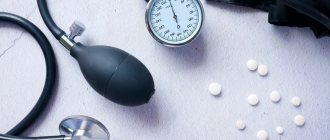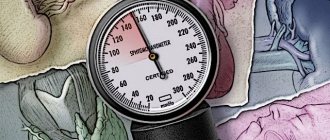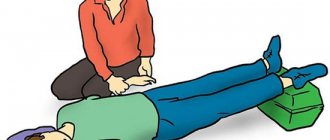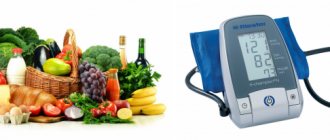A little about pressure
Blood pressure levels are expressed as two numbers, written as a fraction. The numbers mean the following: at the top is systolic pressure, which is popularly called upper, at the bottom is diastolic, or lower. Systolic is recorded when the heart contracts and pushes out blood, diastolic - when it relaxes to its maximum. The unit of measurement is millimeter of mercury. The optimal blood pressure level for adults is 120/80 mmHg. pillar Blood pressure is considered elevated if it is more than 139/89 mmHg. pillar
A condition in which its level remains consistently high is called hypertension, and a stable decrease is called hypotension. The difference between the upper and lower should be 40-50 mmHg. Blood pressure changes throughout the day for all people, but in hypertensive patients these fluctuations are much sharper.
Why do you need to measure blood pressure?
Blood pressure is the force of blood with which it acts on the walls of arteries and blood vessels.
There are diastolic (lower) and systolic (upper) pressure. The norm for an adult is around the boundaries of 120 to 80 mmHg. Significant deviations from these figures often signal the emergence of some disease. Jumps in blood pressure increase the risk of heart attack, ischemia, and stroke.
Increased levels can be observed with the development of the following pathologies:
- heart rhythm disturbances;
- vascular diseases;
- renal failure;
- endocrine diseases;
- neurological disorders.
Low blood pressure is caused by: internal hemorrhages, heart failure, aggravated stomach ulcers, stress, vegetative-vascular dystonia, depression.
It is worth noting that reduced levels may be an individual characteristic of the body. However, high blood pressure almost always signals problems in the body.
To find out exactly the reasons for the jumps, you need to regularly monitor your condition, take measurements, and be examined by a doctor.
Why do you need to know your blood pressure?
Even a slight increase in blood pressure increases the risk of heart attack, stroke, ischemia, heart and kidney failure. And the higher it is, the greater the risk. Very often, hypertension in the initial stage occurs without symptoms, and a person is not even aware of his condition.
Measuring blood pressure is the first thing to do if you complain of frequent headaches, dizziness, or weakness.
Hypertensive patients should measure their blood pressure every day and monitor its level after taking the pills. People with high blood pressure should not sharply reduce it with medications.
Methods for measuring blood pressure
Blood pressure levels can be determined directly and indirectly.
Straight
This invasive method is highly accurate, but it is traumatic because it involves directly inserting a needle into a vessel or cavity of the heart. The needle is connected to the pressure gauge by a tube containing an anti-clotting agent. The result is a curve of blood pressure fluctuations recorded by a scribe. This method is most often used in cardiac surgery.
Indirect methods
Typically, pressure is measured in the peripheral vessels of the upper extremities, namely in the elbow bend of the arm.
Nowadays, two non-invasive methods are widely used: auscultatory and oscillometric.
The first (auscultatory), proposed by the Russian surgeon N. S. Korotkov at the beginning of the 20th century, is based on clamping the shoulder artery with a cuff and listening to the tones that appear when air is slowly released from the cuff. Upper and lower pressure are determined by the appearance and disappearance of sounds that are characteristic of turbulent blood flow. Blood pressure measurement using this method is carried out using a very simple device consisting of a pressure gauge, a phonendoscope and a cuff with a pear-shaped balloon.
When measuring blood pressure in this way, a cuff is placed on the shoulder area, into which air is pumped until the pressure in it exceeds systolic pressure. At this moment, the artery is completely pinched, the blood flow in it stops, and no sounds are heard. As the cuff begins to deflate, the pressure decreases. When the external pressure is compared with the systolic pressure, blood begins to pass through the compressed area, noises appear that accompany the turbulent flow of blood. These are called Korotkoff sounds and can be heard with a phonendoscope. At the moment when they occur, the value on the pressure gauge is equal to systolic blood pressure. When the external pressure is compared with the arterial pressure, the sounds disappear, and at this moment the diastolic pressure is determined using the manometer.
To measure Korotkoff blood pressure, a mechanical tonometer is used.
The microphone of the measuring device picks up Korotkoff sounds and converts them into electrical signals, which are sent to a recording device, on the display of which the values of the upper and lower blood pressure appear. There are other devices in which the arising and disappearing characteristic noises are determined using ultrasound.
The Korotkoff blood pressure measurement method is officially considered a standard. It has both pros and cons. Among the advantages include high resistance to hand movement. There are several more disadvantages:
- Sensitive to noise in the room where measurements are taken.
- The accuracy of the result depends on whether the head of the phonendoscope is correctly positioned and on the individual qualities of the person measuring blood pressure (hearing, vision, hands).
- Skin contact with the cuff and microphone head is required.
- It is technically complex, which causes errors in measurements.
- This requires special preparation.
Oscillometric With this method, blood pressure is measured with an electronic tonometer. The principle of this method is that the device registers pulsations in the cuff, which appear when blood passes through a compressed area of the vessel. The main disadvantage of this method is that the hand must be motionless when measuring. There are quite a lot of advantages:
- No special training is required.
- The individual qualities of the person measuring (vision, hands, hearing) do not matter.
- Resistant to noise present in the room.
- Determines blood pressure with weak Korotkoff sounds.
- The cuff can be worn over a thin jacket, and this does not affect the accuracy of the result.
How to choose a device for measuring blood pressure
Devices for measuring pressure are divided into several groups. Depending on the automaticity of operation, mechanical, semi-automatic and electronic devices are distinguished. And there are also mercury models. In addition to shoulder tonometers (standard), there are also those that measure blood pressure at the level of the wrist, finger, and thigh. Such a large selection allows you to select a device for a specific patient if it is not possible to record blood pressure values in the region of the brachial artery.
Mercury
Mercury devices are highly accurate. They are not used at the present stage at home, due to the need for competence in working with such devices. The error of such devices does not exceed 2 mm Hg. Art., which meets the requirements of international standards. Unfortunately, manufacturers of mercury tonometers indicate that they do not supply such devices to European countries. Why this is so is unknown, because the products are of the highest quality.
Mechanical
They are most often used to determine blood pressure levels in medical institutions. These devices are least dependent on external influences and do not require a battery or batteries. The device consists of a cuff, an air pump equipped with a special valve, tubes and a sphygnomanometer. The only condition for correctly measuring blood pressure is the presence of certain skills that allow you to hear the beginning and end of the appearance of specific knocks, sounds, and noises.
Mechanical blood pressure monitors are considered affordable, accurate, and durable. It is better to have one of your friends or relatives help you measure the patient’s blood pressure, since when you independently pump air into the cuff, oscillatory movements of the hands occur, which can distort the results of the study.
Semi-automatic
Such models are also equipped with cuffs and air blowers, but they do not require the ability to listen to tones, since the diagnostic result is displayed digitally on the device screen. You can purchase a semi-automatic blood pressure monitor equipped with voice functions, which is suitable for visually impaired people.
Machine
Electronic devices are great for measuring your blood pressure yourself, without assistance. All the patient needs is to fix the tonometer cuff in the desired place and press the appropriate button. The device independently pumps in air, releases it independently, and the final result is displayed on the device screen.
Automatic blood pressure monitors belong to the most expensive category of models and require the use of batteries. However, blood pressure measurements may be slightly distorted, since the error of such devices is greater than, for example, that of mechanical or mercury tonometers.
On the wrist and finger
These are automatic compact devices that can be easily carried in a bag and are convenient to use. Devices that are fixed at the level of the wrist joint are recommended for use not only by relatively healthy people, but also by patients with burns and dermatological diseases in the shoulder area. Unfortunately, wrist tonometers have a high error in the results. This is due to the fact that the amplitude between compression and relaxation of the wrist artery is insignificant (due to the size of the cuff).
Measuring the blood pressure level on your finger is a funny, but not logical, from a medical point of view, thing. Finger blood pressure monitors are best viewed as modern gadgets, but not as serious and precise devices. After all, the pressure numbers displayed on the device’s screen will depend on many indicators: air temperature, temperature of the finger itself, humidity level, etc. Finger tonometers are not used in medical institutions.
For the hip
The algorithm for measuring pressure on the femoral artery is practically no different from the standard procedure for recording indicators. The difference in the tonometers used is the size of the cuff and the strength of the Velcro. The girth of such cuffs ranges from 40–66 cm, with the standard 15–22 cm for children, 22–32 and 32–42 cm for adults.
Types of tonometers
Today, aneroid (or mechanical) devices and electronic ones are used to determine blood pressure.
The former are used to measure pressure using the Korotkoff method in a medical facility, since they are too complex for home use, and untrained users receive results with errors when taking measurements.
An electronic device can be automatic or semi-automatic. Such tonometers are intended for daily home use.
Anyone can use an electronic tonometer to measure their own blood pressure and pulse.
General rules for measuring blood pressure
Blood pressure is most often measured while sitting, but is sometimes done while standing or lying down.
People's daily blood pressure is constantly changing. It increases with emotional and physical stress. It can be measured not only in a calm state, but also during physical activity, as well as in breaks between different types of loads.
Since blood pressure depends on a person's condition, it is important to provide the patient with a comfortable environment. The patient himself needs to not eat, not engage in physical labor, not smoke, not drink alcoholic beverages, and not be exposed to cold for half an hour before the procedure.
During the procedure, you should not make sudden movements or talk.
It is recommended to take measurements more than once. If a series of measurements is made, between each approach you need a break of about one minute (at least 15 seconds) and a change of position. During the break, it is recommended to loosen the cuff.
The pressure on different hands can vary significantly; therefore, measurements are best taken on the one where the level is usually higher.
There are patients whose blood pressure is always higher in the clinic than when measured at home. This is explained by the excitement that many feel when they see medical workers in white coats. For some, this can happen at home as well, as a reaction to measurement. In such cases, it is recommended to take measurements three times and calculate the average value.
Difference in blood pressure
Sometimes the diagnosis of other pathologies depends on which hand to measure the pressure on. For example: the kidneys, liver, gastrointestinal tract, pancreas affect the right hemisphere, and the left hemisphere is affected by the lungs, upper limbs and heart. That is why different pressure in the hands has causes not only related to the cardiovascular system, but also to malfunctions of organs.
Finding out the algorithm for measuring blood pressure on different arms is especially important if the difference in indicators is 15 units or more. If such an increase has been observed for a long time, then the chance of complications increases. The patient immediately needs to be examined to find the cause of high blood pressure in the left or right arm.
The affected left or right side of the brain sometimes causes the following symptoms:
- worsening reaction;
- weakness and apathy;
- headaches and dizziness.
People who do not know which arm to measure blood pressure correctly often perform the procedure on one limb. Doctors advise people, especially those with hypertension, to first learn how to measure blood pressure, and then do it on both arms. In this case there should be no error.
Causes of high blood pressure in the left arm
High pressure in the left hand is especially noticeable in left-handed people who actively use the limb. The difference can reach 10-15 units. In people for whom the main right hand is dominant, the indicators on the left limb may also be slightly increased. Doctors explain the deviation as an anatomical feature. On the left arm, nutrition comes directly from the aorta, and on the right – from the brachiocephalic trunk, so the blood pressure level here is lower.
Causes of high blood pressure on the right arm
Blood pressure in the right arm may be slightly higher than the left if the person is right-handed and actively plays sports. Doctors explain this by saying that constant stress on the muscles of the shoulder girdle makes them larger and denser. The arteries passing through this area are compressed, causing blood pressure in the right arm to increase.
The procedure for determining blood pressure in different categories of patients
In the elderly
This category of people often experiences unstable blood pressure, which is associated with disturbances in the blood flow regulation system, decreased vascular elasticity, and atherosclerosis. Therefore, elderly patients need to take a series of measurements and calculate the average value.
In addition, they need to measure their blood pressure while standing and sitting, since they often experience a sharp drop in blood pressure when changing positions, for example, when getting out of bed and sitting.
In children
It is recommended that children measure blood pressure with a mechanical tonometer or an electronic semi-automatic device, and use a children's cuff. Before measuring your child’s blood pressure yourself, you need to consult with your pediatrician about the amount of air pumped into the cuff and the measurement time.
In pregnant women
Blood pressure can tell you how well your pregnancy is going. For expectant mothers, it is very important to constantly monitor blood pressure in order to start treatment on time and avoid serious complications in the fetus.
During pregnancy, blood pressure monitoring is mandatory
Pregnant women need to measure their blood pressure while reclining. If its level exceeds the norm or, conversely, is much lower, you should immediately consult your doctor.
For cardiac arrhythmia
People who have irregular heartbeat sequence, rhythm and frequency should measure their blood pressure several times in a row, discard clearly incorrect results and calculate the average value. In this case, the air from the cuff must be released at a lower speed. The fact is that with cardiac arrhythmia, its level can vary significantly from beat to beat.
Situations in which there is a large difference in blood pressure
Often the problem is that a person does not know how to measure blood pressure correctly. Even if you don’t read the information on the Internet or consult a doctor, the box with each tonometer comes with instructions for measurement, but few people read it.
In more rare cases, the situation is aggravated due to the fact that the person does not understand which arm to measure blood pressure on and constantly does it on different limbs. Gradually, the difference in blood pressure begins to increase, but the patient will not know about it until visible symptoms occur.
Situations associated with pressure differences are as follows:
- One limb has normal pressure and the other has high pressure. In this case, the problem often lies in the development of VSD and anatomical abnormalities of the aorta and other arteries supplying the arms.
- High blood pressure on one limb and even higher on the other. This situation occurs due to the development of hypertension, VSD, as well as due to stress, overload and lack of sleep.
- Low pressure on one limb and high or normal pressure on the other. In this case, we are often talking about blockage of the artery or its compression.
The situations listed above do not arise immediately, but only after a long time. That is why it is important not only to understand on which arm the pressure should be measured, but also to periodically carry out the procedure on both limbs. In this case, the occurrence of many pathologies can be avoided.
Blood pressure measurement algorithm
Blood pressure measurements should be taken in the following order:
- The patient is seated comfortably on a chair so that his back is adjacent to the back, that is, has support.
- The hand is freed from clothing and placed on the table with the palm up, placing a roll of a towel or the patient’s fist under the elbow.
- A blood pressure cuff is placed on the bare shoulder (two to three centimeters above the elbow, approximately at heart level). Two fingers should fit between the hand and the cuff, its tubes pointing down.
- The tonometer is at eye level, its needle is at the zero mark.
- Find the pulse in the ulnar fossa and apply a phonendoscope to this place with slight pressure.
- The valve on the tonometer bulb is screwed on.
- The pear-shaped balloon is compressed and air is pumped into the cuff until pulsation in the artery can no longer be heard. This occurs when the pressure in the cuff exceeds 20-30 mmHg. pillar
- Open the valve and release air from the cuff at a speed of about 3 mmHg. pillar, while listening to Korotkoff sounds.
- When the first constant tones appear, record the pressure gauge readings - this is the upper pressure.
- Continue to release air. As soon as the weakening Korotkoff sounds disappear, the pressure gauge readings are recorded - this is the lower pressure.
- Release air from the cuff, listening to sounds, until the pressure in it becomes equal to 0.
- Allow the patient to rest for about two minutes and measure blood pressure again.
- Then remove the cuff and record the results in a diary.
Correct position of the patient during blood pressure measurement
How to measure pressure correctly
The most accurate result of this diagnosis can be obtained by following certain rules. Distorted indicators will not provide the necessary information content and may lead the patient and doctor to a false conclusion.
Preparation for the procedure
It is recommended to measure blood pressure an hour or more after fitness or smoking. Coffee, tea, energy drinks, a hot shower or bath require you to wait 1.5-2 hours. You should also wait 15-20 minutes. after eating.
It is advisable to empty the bladder and intestines before measuring pressure.
Before starting the diagnosis, you need to sit or lie down for 2 to 10 minutes. The posture during the measurement process should be relaxed, sitting, legs not crossed, not tense. The cuff should be placed correctly on the arm at the same level as the heart. The patient must remain silent.
Before measuring pressure, it is recommended to ventilate the room and ensure a comfortable air temperature.
Mechanical measurement algorithm
- Prepare the device. Remove the tonometer from the packaging and place the meter on a flat surface, ensuring a good view of the dial. Straighten all the tubes.
- Put on the cuff. Wrap the material around your bare forearm (2-3 cm above the elbow). Fasten tightly, but not too tight.
- Install a phonendoscope. Place the membrane under the cuff just above the elbow (on the inside of the arm). Insert headphones into your ears.
- Inflate the cuff. Take the bulb in your palm and tighten the valve tightly in a clockwise direction until it stops. Squeeze the bulb with quick movements until the cuff is filled with air and the monometer needle reaches 180 mm Hg. At this stage, a slight numbness of the arm may be felt due to blockage of blood flow in the artery.
- Start the measurement itself. Slowly open the bulb valve counterclockwise, gradually releasing air. In this case, it is necessary to monitor the dial needle and the tone in the ears. The first beat heard will occur at the systolic pressure mark, the last one at the diastolic pressure mark. Remember these indicators.
- Finish the procedure. As soon as the beats in the headphones have completely stopped, you can deflate the remaining air, remove the cuff and stethoscope, and put away the device.
If you were unable to listen to the readings, you can inflate the cuff again during the measurement process. You cannot repeat the manipulation more than once, because this distorts the data.
Electronic measurement algorithm
- Preparing the device. Place the tonometer body on a flat surface and straighten all the tubes well.
- Prepare your hand. Take off your watches, bracelets, roll up your sleeves.
- Put on the cuff. Place the fabric on the forearm above the elbow 2 cm.
- Patient preparation. Take a relaxed sitting position with straight legs. Keep your hand calm, it is better to rest it on the table with your palm up. Shut up and breathe evenly for about 30 seconds.
- Measurement. Press the start button according to the instructions. The cuff will begin to inflate and running numbers will appear on the screen. Without changing position, wait until the air is completely deflated and the readings on the monitor stabilize.
- Remove the device. Remove the cuff and stop the device.
When measuring with a wrist tonometer, you should also remove jewelry from your hand and expose your skin. The cuff is put on with the display up 1 cm above the hand. The hand with the device is placed palm down on the opposite shoulder. This is followed by startup, inflation of the cuff, appearance of indicators and deflation.
For maximum accuracy, the diagnosis can be repeated after 15 minutes.
Wrist blood pressure measurement technique
To measure blood pressure at the wrist with an electronic device with a cuff, you must follow the following instructions:
- Remove watches or bracelets from your wrist, unbutton the sleeve and fold it back.
- Place the tonometer cuff 1 centimeter above the hand with the display facing up.
- Place the hand with the cuff on the opposite shoulder, palm down.
- With your other hand, press the “Start” button and place it under the elbow of your cuffed arm.
- Remain in this position until the air is automatically released from the cuff.
This method is not suitable for everyone. It is not recommended for people with diabetes, atherosclerosis and other blood supply disorders and changes in the vascular walls. Before using such a device, you need to measure the pressure with a tonometer with a cuff on the shoulder, then with a cuff on the wrist, compare the obtained values and make sure that the difference is small.
A wrist blood pressure monitor has both advantages and disadvantages.
What to consider when measuring pressure
- Stress can significantly change the readings, so you need to measure it in a calm state.
- Blood pressure increases with constipation, immediately after eating, after smoking and drinking alcohol, with excitement, and in a sleepy state.
- It is best to carry out the procedure one to two hours after eating.
- Blood pressure should be measured immediately after urination, since it is elevated before urination.
- The pressure changes when taking a shower or bath.
- A nearby mobile phone can change the tonometer readings.
- Tea and coffee can change blood pressure.
- To stabilize it, you need to take five deep breaths.
- It increases when you are in a cold room.











